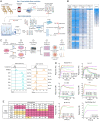Dromedary camel nanobodies broadly neutralize SARS-CoV-2 variants
- PMID: 35476528
- PMCID: PMC9170159
- DOI: 10.1073/pnas.2201433119
Dromedary camel nanobodies broadly neutralize SARS-CoV-2 variants
Abstract
The severe acute respiratory syndrome coronavirus 2 (SARS-CoV-2) spike is a trimer of S1/S2 heterodimers with three receptor-binding domains (RBDs) at the S1 subunit for human angiotensin-converting enzyme 2 (hACE2). Due to their small size, nanobodies can recognize protein cavities that are not accessible to conventional antibodies. To isolate high-affinity nanobodies, large libraries with great diversity are highly desirable. Dromedary camels (Camelus dromedarius) are natural reservoirs of coronaviruses like Middle East respiratory syndrome CoV (MERS-CoV) that are transmitted to humans. Here, we built large dromedary camel VHH phage libraries to isolate nanobodies that broadly neutralize SARS-CoV-2 variants. We isolated two VHH nanobodies, NCI-CoV-7A3 (7A3) and NCI-CoV-8A2 (8A2), which have a high affinity for the RBD via targeting nonoverlapping epitopes and show broad neutralization activity against SARS-CoV-2 and its emerging variants of concern. Cryoelectron microscopy (cryo-EM) complex structures revealed that 8A2 binds the RBD in its up mode with a long CDR3 loop directly involved in the ACE2 binding residues and that 7A3 targets a deeply buried region that uniquely extends from the S1 subunit to the apex of the S2 subunit regardless of the conformational state of the RBD. At a dose of ≥5 mg/kg, 7A3 efficiently protected transgenic mice expressing hACE2 from the lethal challenge of variants B.1.351 or B.1.617.2, suggesting its therapeutic use against COVID-19 variants. The dromedary camel VHH phage libraries could be helpful as a unique platform ready for quickly isolating potent nanobodies against future emerging viruses.
Keywords: SARS-CoV-2; cryo-EM; dromedary camel nanobody VHH; neutralizing antibody; single-domain antibody.
Conflict of interest statement
Competing interest statement: M.H. and J.H. are inventors on provisional patent application no. US 63/105,769 assigned to the NIH, “Single domain antibodies targeting SARS coronavirus spike protein and uses thereof.”
Figures





Update of
-
Camel nanobodies broadly neutralize SARS-CoV-2 variants.bioRxiv [Preprint]. 2021 Oct 29:2021.10.27.465996. doi: 10.1101/2021.10.27.465996. bioRxiv. 2021. Update in: Proc Natl Acad Sci U S A. 2022 May 3;119(18):e2201433119. doi: 10.1073/pnas.2201433119. PMID: 34751270 Free PMC article. Updated. Preprint.
References
Publication types
MeSH terms
Substances
Supplementary concepts
Grants and funding
LinkOut - more resources
Full Text Sources
Medical
Molecular Biology Databases
Miscellaneous

